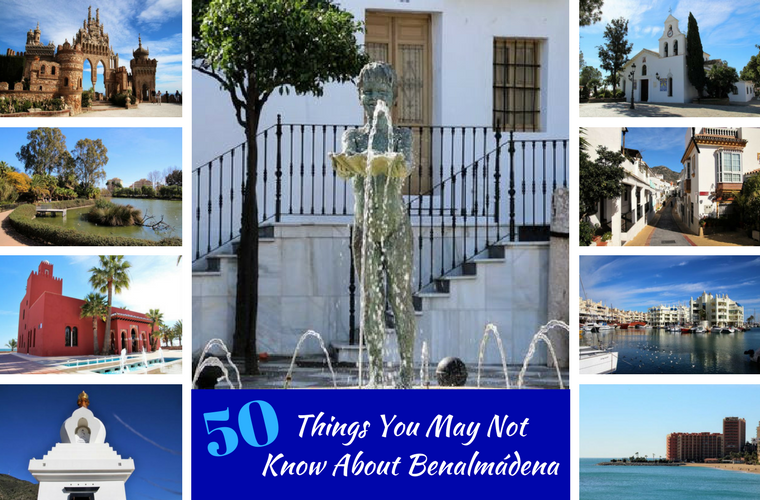 Benalmádena is one of the Costa del Sol’s most popular holiday resorts welcoming visitors from all over the world. Located just 22km from Málaga city centre and a short 20-minute drive from Málaga Airport, Benalmádena offers visitors a wide variety of attractions, beaches, hotels, restaurants and activities which make it the ideal holiday destination.
Benalmádena is one of the Costa del Sol’s most popular holiday resorts welcoming visitors from all over the world. Located just 22km from Málaga city centre and a short 20-minute drive from Málaga Airport, Benalmádena offers visitors a wide variety of attractions, beaches, hotels, restaurants and activities which make it the ideal holiday destination.
There are so many interesting facts about Benalmadena which we’re sure many visitors – and even locals – might not be aware of, that we decided to put together this comprehensive list of 50 Things you may not know about the municipality. Let’s see if we can surprise you!
General Information
#1: The municipality of Benalmádena is made up of three different districts or urban centres: Benalmadena Pueblo, Arroyo de la Miel and Benalmádena Costa.
#2: All three districts together occupy a little more than 27 square kilometres of land.
#3: The official number of inhabitants (as of 2016) is 67245, although the real number is probably closer to 80,000 people. This figure triples in the summer months when thousands of holiday makers visit Benalmadena for their holidays.
#4: 17,345 of the inhabitants of Benalmádena are foreigners with 34% of these being British.
#5: Benalmádena is twinned with Finale Ligure, a municipality in Savona, on the Italian Riviera. This is because it was the birthplace of Felix Solesio, the man responsible for the first urban settlement which later became Arroyo de la Miel.
#6: The highest points on the map of Benalmádena are Cerro del Castillejo (967 metres above sea level), Cerro del Moro (959 metres above sea level) and the more well-known Monte Calamorro (771 metres above sea level) and the final destination for the Cable Car which leaves from the Tivoli World car park.
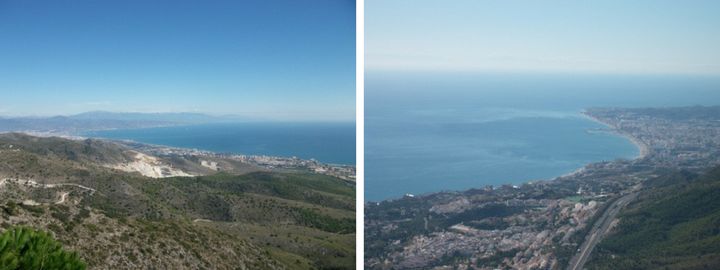
The views from Monte Calamorro… stunning!
#7: Benalmádena Pueblo, the old town nestled in the hills, originates from the Moorish occupation of Spain when defensive walls and a fortress were built to protect the village.
#8: The Arroyo de la Miel area of Benalmádena originated from an old country house (cortijo) around which, in the 18th century, six paper mills were built to produce playing cards as well as various farming businesses.
#9: Arroyo de la Miel (Stream of Honey) got its name thanks to the vast number of beehives spread over the area.
#10: Whilst there is no definitive explanation of how Benalmádena got its name, one of the most popular hypothesis amongst historians relates the name to the Arabic word Ibn al-ma´din (sons of the mines) due to the existence of iron ore mines in the area.
#11: There are quite a few famous celebrities who come from Benalmádena including, Real Madrid footballer, Isco; heartthrob singer, Pablo Alborán and politician, Celia Villalobos.
A few historical facts about Benalmádena
#12: The first human settlements in the area of Benalmádena date back 20,000 years to the Upper Palaeolithic or Late Stone Age. Proof of this can be found in the archaeological remains found in three caves located in the municipality; Cueva del Toro, Cueva del Botijo and Cueva de la Zorrera.
#13: The 7th and 8th Centuries BC saw the arrival of the Phoenicians who were interested in the mineral resources of the area.
#14: The Phoenicians were replaced by the Roman Empire who were keen to capitalise on the area’s resources. Today we can still see the remains of the Roman occupation with various sites including, the Benal-roma ruins (an old salt factory), the ruins in Torremuelle as well as archaeological artefacts recovered from the sea floor and now exhibited in the Museo de Benalmádena (Benalmádena Museum).
#15: During the 11th century – after the Moorish invasion – life in Benalmádena took place within the enclosed walls of the town and fortress which were built to protect the town from attack. During this time the Moors developed agriculture with the introduction of products like sugar cane, figs and grapes.
#16: The fortress and town were destroyed in 1496 by the Christian armies under the command of Henry IV of Castilla. The villagers sought refuge in neighbouring Mijas.
#17: In the 17th century the municipality of Benalmádena was practically reduced to rubble by a devastating earthquake and the tsunami which followed.
#18: In the 19th century Benalmadena experienced considerable growth thanks to the production of ‘moscatel’ grapes to make wine. However, a devastating plague ruined all the crops.
#19: The 1950’s saw the start of the tourism boom which resulted in Benalmádena becoming one of Spain’s most popular tourist destinations.
Benalmádena’s Economy
#20: Benalmádena’s economic activity centres around tourism, construction and activities deriving from both of these areas.
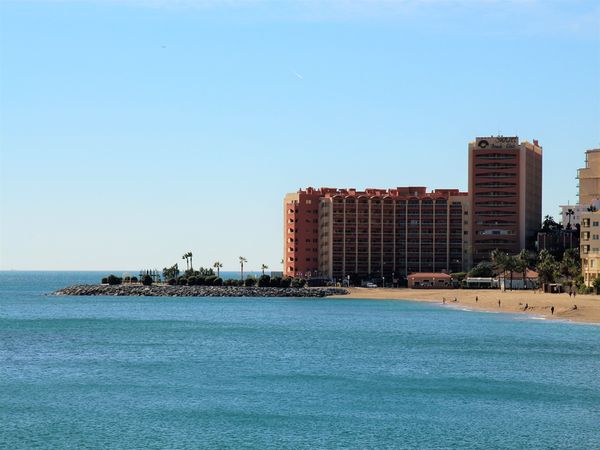
Sunset Beach Club hotel with 553 rooms!
#21: There are almost 13,000 hotel beds in Benalmádena, making it one of the Costa del Sol’s municipalities with the highest number of hotel rooms.
#22: Agriculture and traditional Industries are practically non-existent in Benalmádena with a mere 16 hectares dedicated to the cultivation of avocados, ornamental flowers and olive trees. Fishing is also limited due to the fact that the Marina is strictly used for leisure boats and there is no fishing fleet.
Interesting facts about Benalmádena’s main tourist attractions
#23: The Colomares Castle (Castillo Colomares) was built as a tribute to Christopher Columbus and the Discovery of America. Its 1500 square metres make it the largest monument dedicated to Columbus.
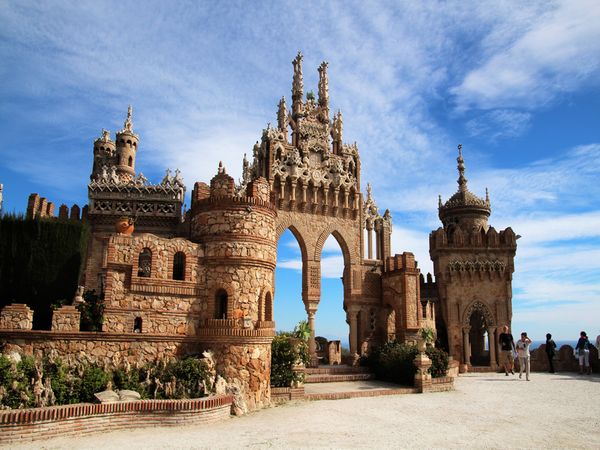
Colomares Castle
#24: The Cueva del Toro (Bull’s Cave) located in Mount Calamorro was discovered in 1969 and is Benalmádena’s most important prehistoric site. It was occupied more than 15,000 years ago and contains cave paintings.
#25: Along Benalmadena’s coastline you can find three old watch towers: Torremuelle, Torrequebrada and Torre Bermeja. Some of these formed part of the defence system built in Western Andalucia to protect against the attacks of the Moors, and later to protect the Mediterranean coast from pirates.
#26: The Torrequebrada Casino, located just minutes from the hotel, was built in 1979 and was the Costa del Sol’s first Casino. It’s one of the most visited Casinos in Spain with 130,000 people passing through its doors every year.
#27: La Niña de Benalmádena is a bronze sculpture which has become one of the city’s icons. You’ll find her in the centre of the fountain in the centre of the Pueblo’s Plaza de España. The sculpture represents a young girl with her hair in a ponytail offering water in a shell.
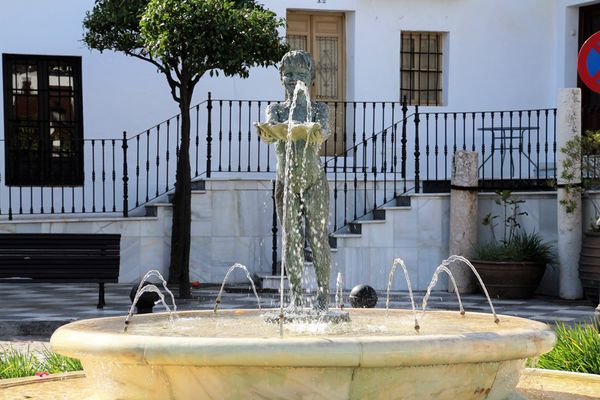
La Niña de Benalmádena Bronze Sculpture
#28: Paloma Park located in the centre of Arroyo de la Miel is a 200,000 square metre green area with gardens, trees and a large lake. One of its most distinctive characteristics is the fact that you’ll find wild animals (rabbits, chickens, ducks, swans, peacocks and more!) running around freely.
#29: Tripadvisor recently included Paloma Park in its list of the 25 Most Beautiful Parks in Europe. It shares this honour with world famous landmarks such as Hyde Park in London and El Retiro in Madrid!
#30: Towering high above Paloma Park is the largest flag pole in the region.
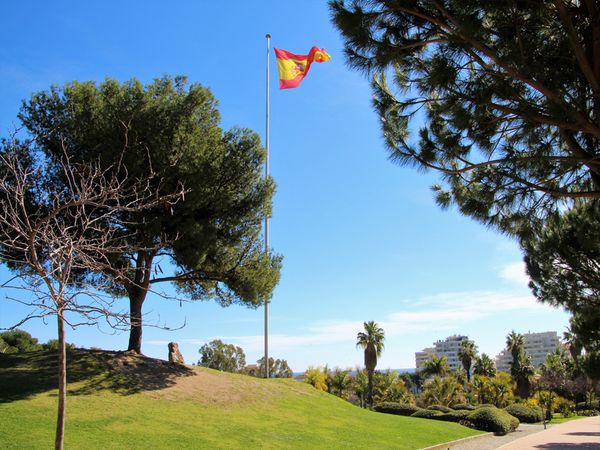
Paloma Park has The largest Flag Pole in the region!
#31: Tivoli World is the only amusement park on the Costa del Sol and another of Benalmádena’s most emblematic tourist attractions. It’s been open to the public since 1973 and the park’s popular concert hall has featured world famous artists including, James Brown, Boney M, Julio Iglesias, Montserrat Caballé, Antonio Machín and Alejandro Sanz.
We found this old video of Tivoli World in the 1980’s which shows what the park was like in its early days…
#32: The Jardines del Muro area of Benalmadena Pueblo is where the old fortress was located. This garden and park area boasts stunning views of the Coast and is home to Benalmádena’s oldest church, Santo Domingo de Gúzman.
#33: Selwo Marina is the only facility of its kind in Andalucia with a dolphinarium featuring amazing dolphin shows and an ice penguinarium where visitors can feed penguins.
#34: The Sealife aquarium in the Marina is just one of many aquariums belonging to Merline Entertainment Group. You may recognise their logo from visits to cities such as London and Brighton which also have their own Sealife aquariums.
#35: When Benalmádena’s Marina first opened in 1979, it was actually named Puerto Príncipe; however, it was renamed Puerto Marina in 1982.
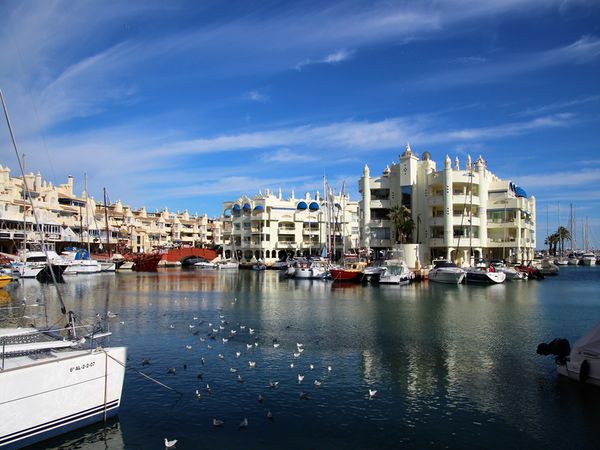
BEnalmadena’s famous Marina
#35: Puerto Marina’s unique architecture has earned it the distinction of “Best Marina in the World” on two separate occasions.
#36: The Buddhist Stupa in Benalmádena Pueblo opened to the public in 2003 and is the largest of its kind in the western world. It’s so large that it has a meditation room in the interior, something that is rare in these fascinating structures.
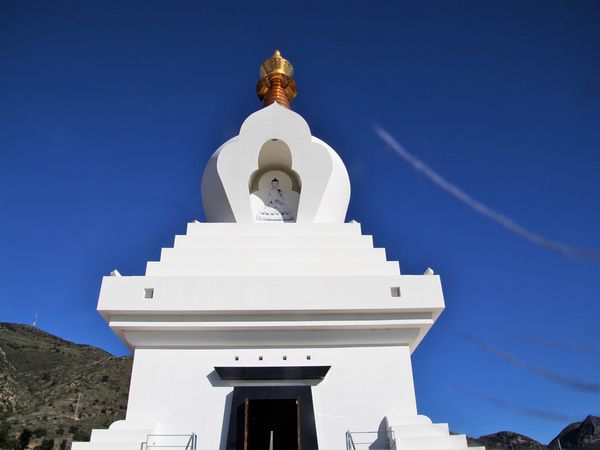
The Stupa Buddhist Temple… the largest in the western world
The Beaches and the Weather in Benalmádena
#37: Benalmádena has almost 20 kilometres of coastline and a total of 17 fantastic beaches.
#38: The beaches on the eastern side of the municipality are long, wide and equipped with public services and feature water sports and other fun activities. Whilst the beaches on the western side are rockier, with many located in quiet coves nestled between small cliffs.
#39: Benalmádena also boasts one of the first nudist beaches in Spain called Benalnatura.
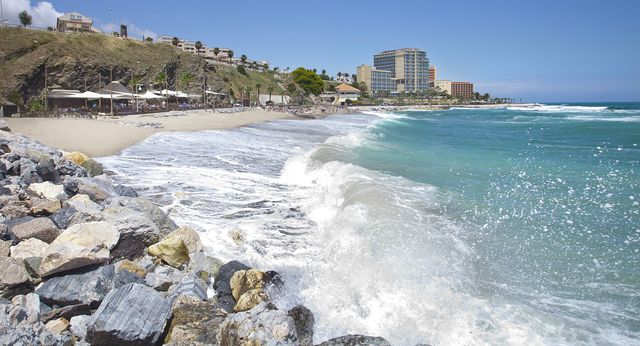
Torrevigia Beach… home to Luna Beach Club 🙂
#40: Benalmádena enjoys year-round fabulous weather with 320 days of sunshine per year and only 43 days of rain per year.
#41: The average maximum monthly temperature in Benalmádena is 23ºC!
Public Transport and Getting Around Town
#42: Benalmádena forms part of the Transport Consortium for the Malaga Metropolitan Area which offers a travel card system allowing visitors and locals to use this on all local buses in Benalmádena and Málaga City, those that connect Benalmádena with Málaga as well as the train that runs from Fuengirola to Málaga. You can read more about this service here.
#43: For something a little different, visitors can travel to neighbouring Fuengirola and into Málaga city centre by hopping on the ferries that leave from Benalmádena Marina on a daily basis in the high season (best to check timetables before making plans).
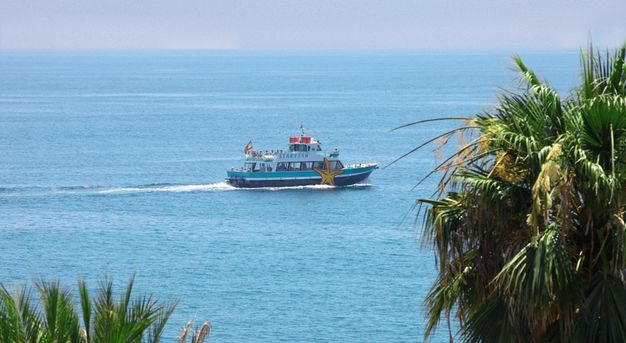
The ferry that runs from Benalmadena to Fuengirola
#44: Those looking for a full tour of Benalmádena can jump on the local hop-on, hop-off double decker tourist bus which stops at all of the city’s main tourist attractions.
Cultural Events & Public Holidays
#45: Every year to welcome Spring, the Marina hosts its Feria del Marisco (Seafood fair) where you’ll be able to enjoy all your favourite seafood dishes at discounted prices.
#46: During the summer months of July, August and September, Benalmádena hosts it’s Summer Festival (Festival de Verano de Benalmádena) which offers a wide selection of cultural events including live music, theatre and cinema. This event takes place in the Municipal Auditorium located in Paloma Park.
#47: Every Autumn Sunset Beach Club hotel hosts Benalmádena’s International Blues Festival which takes place in the Moonlight Bar.
#48: The Corpus Christi Festivities in Benalmádena Pueblo are a must-see for all who visit during the month of June. The town’s streets are covered in flower petals making for an unbelievable sensory experience.
#49: On the evening of 23rd June, the beaches of Benalmádena fill up with people celebrating the Night of San Juan and the start of the Arroyo de la Miel fair. Bonfires, fireworks and late night swims make for a fun evening!
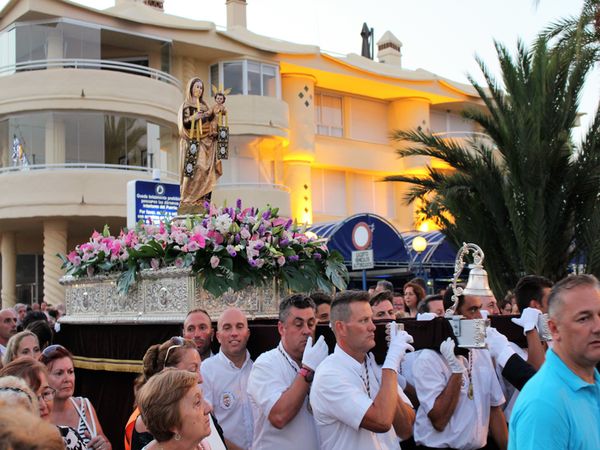
The Virgen del Carmen being carried through the Marina
#50: The Virgen del Carmen processions which take place in the Marina in the middle of July celebrate the patron saint of fishermen. If you can make it down to the Marina in the evening, we highly recommend it as it’s a fascinating spectacle and Spanish culture at its finest.
And that’s the end of our list… how many of those facts did you know?
If you’re thinking about visiting Benalmádena, Sunset Beach Club Hotel is beautifully located on the seafront and within easy reach of many of the city’s most popular attractions (and many of the places mentioned in this post). You can find more information and check prices and availability on the website www.sunsetbeachclub.com.
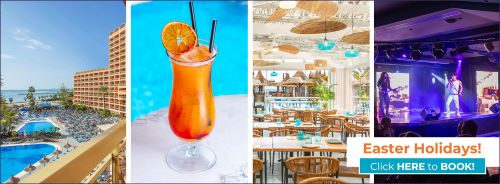




Having had an apartment for 28 years living in the area & now just holidaying there l have seen this place grow. It is beautiful & l have visited many area shown here past years & present. Thank you for sharing there were lots of things l wa not aware of or facts about places. But one thing for sure l ❤️ Benalmadena.
Thanks for your kind words Lynn, glad you enjoyed the post 🙂
Will be going there in July book apartment MSAlay.I don’t really know much about this apartment.
Had apartment many years ago in Arroyo del miel..regretted selling it.
That was 10years ago havnt been back since then.so I’m looking forward to see Benalmadena again.
‘re bus card how do I buy it?
You buy the bus card in a tobacconist (they call them ‘estancos’ here)